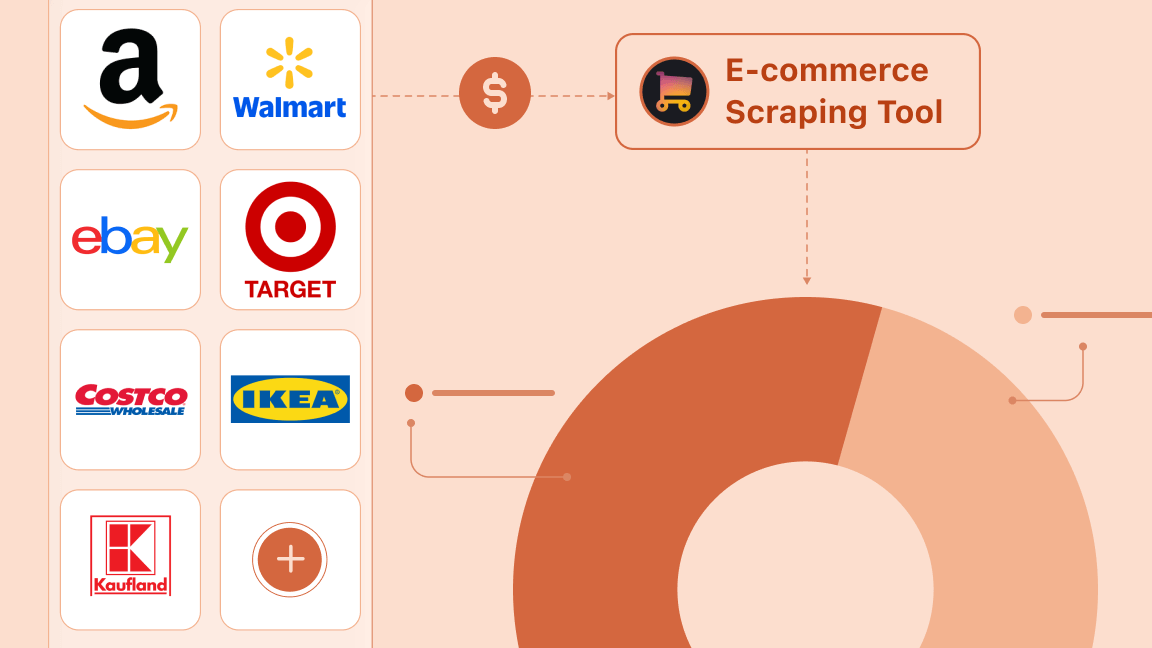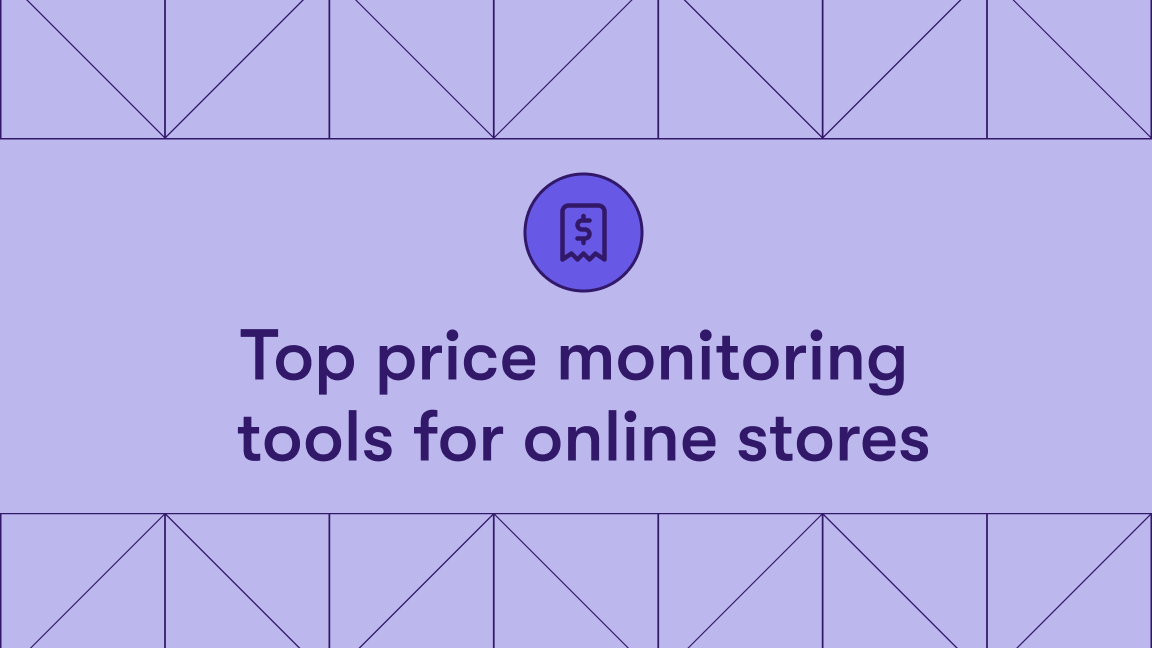Who doesn’t like a deal? No matter what you’re in the market for, online shopping has made it easier than ever to find the best price. So, understanding how and when your competitors set prices is increasingly important.
This guide will help you learn all about price monitoring - what it is, why it matters, and how to do it effectively. We'll cover the basics and various solutions, show you how to use Apify's tools, and walk you through setting up your own system. With this guide, we’re confident you'll have a solid grasp of how to get started with price monitoring.
What is retailer price monitoring?
Retail price monitoring is the process of tracking the pricing changes of products or services offered by various retailers. Monitoring allows you to develop and adjust a dynamic pricing strategy to remain competitive or attract new customers.
A typical price monitoring system saves time and resources and usually involves the following steps:
- Collect pricing information from various sources (like e-commerce websites).
- Analyze data to spot trends, patterns, and changes in pricing strategies.
- Display the analyzed data in user-friendly dashboards or automated reports.
- Act on the data you collect to build a solid pricing strategy.
Why invest time and effort in setting up price monitoring for your business?
Prices change in a blink. Your competitors might suddenly offer a discount or gradually raise prices over time. With monitoring, you can see these changes and adapt. But price monitoring isn't just about reacting to the market, it’s a proactive way to strengthen your business strategies, helping you build a pricing strategy by:
- Understanding market trends
- Finding the best times for sales
- Spotting better deals from suppliers
Plus, if you have an order management system in your eCommerce, this can ensure you don’t overprice or underprice the products you deliver.
Advantages and use cases of retailer price monitoring
Competitive edge: Understand your competitors' strategies to stay ahead.
Market trend identification: Spot industry-wide pricing trends to be a market leader.
Profit maximization: Fine-tune your prices to hit that sweet spot between competitiveness and profitability.
Better pricing decisions: With price monitoring, you're equipped with data to back up your pricing choices.
Customer satisfaction: Fair pricing keeps customers loyal. Price monitoring helps you stay in line with the market, so you’re not overcharging.
Dynamic pricing: Utilize dynamic pricing strategies. Adjust your prices automatically based on the market.
Supplier negotiation: Accurate market data can help you get a leg up when dealing with your suppliers.
Regulatory compliance: In some industries, price monitoring can keep you legally compliant.
How to set up retailer price monitoring
Let's set up a price monitoring system using an Apify Actor. We'll use Content Checker, which is great for tracking web page changes, including prices. Here's how to do it:
1. Sign up for Apify
First, go to Apify's website and create an account. You can choose the free plan - it’s more than enough to start and experiment with.
2. Navigate to Content Checker
Once you're logged in, search for Content Checker in Apify Store. Next, click "Try for free" to open the Actor's configuration page:
3. Configure the Actor
Now, we’ll begin setting up Content Checker:
In the "URL to check" section, enter the URL of the product pages you want to monitor. Here, we'll use a mock online store:
To monitor the price of these earbuds, you need to find a CSS selector of the HTML element that contains the price. Then enter that value into the "Monitored area selector" field in the Content Checker control panel.
To find the CSS selector of the price on the page, you'll need to right-click the price and click the "Inspect" option:
Here, you can see that the price is located in the span element with the CSS selector price, so you'll enter ".price" in the "Monitored area selector" field. Don’t forget the dot before the name of the CSS selector.
To set up price change notifications, go to the control panel and locate the "Email address" field. Enter the email address where you want to receive alerts. This creates a basic monitor that will notify you whenever the price changes.
Your configuration should look something like this:
When the price changes, you'll receive an email containing a screenshot of the changed HTML element. If you want a screenshot of some other section of the page, you can specify the CSS selector of that section in the "Screenshot selector" field of the control panel.
4. Save and run the Actor
Now, let's save this Actor configuration, so that you can use and reconfigure it later. Additionally, you have to create a task from this configuration so you can schedule it to run automatically. You'll do that by clicking the "Create task" button on the upper-right section of the control panel:
That will prompt you with the configuration window for creating a new task from an Actor where you can name it.
After clicking "Continue," you'll see the task configuration page. This page mirrors the Actor settings but is separate, allowing you to create multiple tasks from one Actor.
Click "Start" to launch your price monitoring system. You'll see a log showing the task's progress and results. The system will display a screenshot of the monitored area and the captured price data.
5. Set up a schedule
You already ran the task once, but if you want the Actor to periodically check the specified pages and alert you to any changes, you'll have to set up a schedule for the task you previously created.
To do that, navigate back to the "Saved tasks" on the left sidebar and select the task you want to schedule - in this case, "Price monitor":
Then, when you enter the task control panel, click the three dots on the upper-right side and select "Schedule":
That will open the "Schedule Actor task" window. Here, you can specify how often you'd like this task to run:
Set the task to run as often as you need. For this example, we'll check prices every hour. Choose the "Hourly" tab and select the default option. You can explore custom schedules later if you need to. When you're done, scroll to the bottom of the "Schedule Actor task" window and click "Create" to set up your hourly price checks.
To confirm if the task has been scheduled, go to "Schedules" in the left sidebar. Here, you can see the schedule you created listed among the entries:
That’s it! You've set up a system to track price changes for the earbuds on the mock online store. It will check hourly and notify you by email when it detects any changes.
As you get comfortable with the system, you can add more URLs to monitor additional products, tweak the CSS selectors if you're not capturing the right data, and adjust the run interval based on how frequently prices change in your market.
6. Monitor and maintain
Keep an eye on your Actor runs to ensure everything's working smoothly. Periodically review and update your monitored URLs and selectors, as websites may change their structure over time.
Remember, this is just the beginning. As you get more comfortable with Apify, you can create more complex Actors to handle advanced scenarios, integrate with other tools, and even build a custom price monitoring dashboard.
For more detailed instructions and customization options, check out our Content Checker tutorial on YouTube.
Best retailer price monitoring tools
Before we look at specialized tools, let's be clear: while these are built for price monitoring, they're often expensive and might not fit all needs. Apify is a more flexible and affordable option. Still, it's worth knowing about some popular choices.
Prisync
Prisync offers real-time price and stock monitoring for e-commerce businesses. It's known for its user-friendly interface and customizable reports.
Price: Starts at $99/month for up to 100 products, with higher tiers for more extensive monitoring needs.
Price2Spy
Price2Spy offers a suite of price monitoring tools, including MAP (Minimum Advertised Price) violation detection.
Price: Starts at $134.95/month for up to 100 products, scaling up based on volume.
Competera
Competera is a pricing optimization and competitive intelligence platform. It helps businesses of all sizes with pricing processes based on market changes and competitor strategies.
Price: Individual and available by request.
Minderest
Minderest focuses on dynamic pricing and marketplace monitoring. It's popular among brands selling on multiple platforms.
Price: Custom pricing, generally starting around $500/month for basic features.
Apify
Apify is more than just a price monitoring tool. It's a versatile web scraping and automation platform. Unlike pre-built tools, with Actors like the Content Checker, you can build a system that matches your unique needs. You can monitor prices on particular websites or track prices alongside other product data.
Price: Apify pricing starts at just $49/month for the Personal plan, offering incredible value and flexibility compared to specialized tools. Plus, there's a free plan to get you started!
How to choose the right price monitoring tool
Budget and scalability
Specialized price monitoring tools can be pricey, especially for smaller businesses. Apify offers a more affordable option that grows with you. You can start small and scale up whenever you need.
Customization
Off-the-shelf solutions might work for some, but what if you need something specific? With Apify Actors, you can build exactly what you need.
Ease of use
You don't need to be a coding expert to use Apify. It's built with developers in mind but comes with clear guides and examples to help you get started quickly and confidently.
Fresh, accurate data
Stale data won't do you any good. Make sure your tool gives you up-to-date information. With Apify, you can set how often you want to check prices, so your data is always fresh.
Integration
Apify works exceptionally well with other tools. You can easily feed your price data into your current systems or workflows using APIs and webhooks. Check out Apify Integrations to find your favorites.
Support and documentation
When you get stuck, good help is priceless. Apify has detailed guides, active user forums, and quick support to get you out of any tricky situations.
Picking the right tool for your business
- Small businesses and startups: Apify is your best bet. It's cost-effective, flexible, and scalable.
- Medium-sized e-commerce businesses: Specialized tools like Prisync or Price2Spy have their benefits, but Apify gives you more for your money. You can build custom price monitoring that fits your exact products and rivals.
- Large enterprises: Competera and Minderest offer advanced analytics, but Apify gives you options. Build your own price monitoring system or work with our experts to create a premium, enterprise-level solution.
- Niche industries: For specialized fields, standard tools might fall short. Apify Professional Services should be able to assist you with a solution tailored for your business.
Put price monitoring to work
Price monitoring helps you understand competitors, set better prices, negotiate with suppliers, and boost profits. Apify offers a flexible, affordable solution that grows with your business and transforms data into smart strategies. With Apify, you can build a custom solution that fits your business. Begin small, try new things, and explore what's possible!
Interested in learning more about developing a pricing strategy? Browse Apify Store's e-commerce section for specialized web scrapers that extract product data from across the web. Here's a quick list of some of our most popular e-commerce scrapers:
| 🛒 Amazon Scraper | 🛍 AliExpress Scraper |
| 🛒 Google Shopping Scraper | 📈 Amazon Best Sellers Scraper |
| 🛒 Etsy Scraper | 📦 Facebook Marketplace Scraper |





